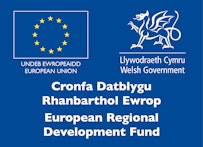Collaborative project practicalities
For many companies, working with the DIA might be their first experience of collaborating on a research project with a university. The DIA has a very specific focus: data science for innovation in small companies.
Purpose of a project
The DIA has been part-funded by the European Regional Development Fund through Welsh Government to support companies to explore data science as part of their innovation journey.
In a project, the DIA team will work collaboratively with you to address technology and data science research questions to enable the development of a (new) product/process/service, which might be in-house or something to develop for sale to clients.
The scope and size of a project will depend on its aims and objectives. A typical project might last 6-9 months with part-time staff input from both sides.
The information on this page relates to collaborative research and development projects, and not to data innovation health checks.
Your contribution
We will carry out collaborative projects with companies, often on a bilateral basis, but occasionally bringing in additional partners with relevant expertise and knowledge.
These projects will have defined aims and objectives - for example, to carry out analytics on a particular data set to develop a new product or service that the company can sell to its customers.
To ensure we abide by European and UK law on use of public funds for supporting the private sector (state aid), companies will need to contribute to collaborative projects. This contribution will be in the form of staff time and/or declaring the purchase of software or cloud services necessary for participation in the project. In order for us to demonstrate that the project is a collaboration according to the European Commission's definition, your contribution will need to match or slightly exceed the University's in terms of cash-equivalent value.
The size and shape of a project will of course depend on the content, but a typical project might last for 6-9 months, with a £25-35K input from the University. We will always do our best to ensure that the collaboration can accommodate your needs, so will offer flexibility when we can. We will guide you through this whole process, making it as straightforward and user-friendly as possible.
Intellectual property
In order to ensure smooth running of the research and ensure adequate state aid cover, the Data Innovator Accelerator's standard approach to projects is that they are a ‘collaboration’ with objectives jointly defined by both parties, to which both parties contribute resources and of which both parties share the risks and outcomes.
Collaborative projects: Project results
Who will own any results from the project?
In order to demonstrate compliance with state aid rules, any results from a project will be owned by the party that creates it. If the parties work jointly and produce results that cannot be separated, it shall be owned jointly in proportion to the parties’ respective contributions.
What about pre-existing information that is used in the project?
Pre-existing information used in connection with the project will remain the property of the party introducing it. However, both parties will give free rights to the other to use their pre-existing information for the purposes of the project.
What access will a partner company have to University’s results?
The University will allow you to use its results on a non-exclusive basis for free in the relevant field for a period of 3 years.
What access will the University have to the partner company’s results?
The company will be expected to allow the University to use its results on a non-exclusive basis for free for the University’s own non-commercial activities, such as teaching and scientific research.
